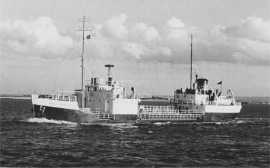The Final Analysis.
In re-examining the reasons which led to the loss of the training ship 'HMS Conway' during her outward shift in the Menai Strait on 14th April 1953, the focus of attention has invariably all been upon the events and personalities of that day. Yet this is no more than to address the not entirely unpredictable consequences of that questionable decission in 1949 to send an unprecedented deep ship from her Bangor mooring through that treacherous stretch of water between the two bridges, known as The Swellies, to a mooring off the newly aquired shore establishment, Plas Newydd.
1/, The Draft : Emrys Jones (Caernarvon Pilot) told me that the biggest ship ever to have doubled the transit of The Swellies was the Shell Supplier, which little ship would load to a maximum draft of 16' 6", although she may not have been as deep as this when she visited Caernarvon.
m.v. Shell Supplier
Although Conway was not very much longer than this handy little vessel, she had 70% greater beam, and at (a fixed) 22 feet draft she was at least 5' 6" deeper, which was extremely significant in a waterway where at the critical time 'Conway' would be required to make the outward transit the difference between the lowest and even the highest tides of the year was only 4' 9". (page 14)
Emrys also told me that in his day, and even on a big spring tide he regarded 17'6" through The Swellies as "The absolute maximum". However
his need to berth at Caernarvon on the last of the Flood meant he regularly 'powered' these little ships through The Swellies against the flood about two hours before Local High Water Britannia Bridge, when in quiet weather and mean barometric conditions the least depth (Cheese Rock) would be 15.25 + Sin[ 90 ~ (120/337 x 180)] x 20.3/2 = 19 ft 8 inches (See page 11). So Emrys was looking for a clear two feet underkeel clearance as the 'absolute minimum'. This is little enough margin for error in the uncertainties of a tideway and we do have to respect his practiced judgement, by which definition 'Conway', at 22 ft draft, could not be expected to make the transit with anything less than 24 ft over the rock.
Fig. 8 shows that, being the highest tide of the year, there would have been 24 ft over the rock (in theory) at 0908 that morning, and since that was also the time when (in theory) 'The Slack' at Britannia Bridge could be expected, then (in theory) the outward transit was possible. But this takes no account of the strong NW wind at sea that morning which would have reduced the height of the tide in all South South Irish Sea areas. In theory again, that wind would also have advanced the time of 'The Slack', but the stream didn't reverse direction that morning until 0925 - a few minutes after 'Conway' had passed under the bridge. - (and 0925 was precisely the time the Caernarvon Harbourmaster had recommended starting the transit!).(Loss 3)
On page 7 Dr Sherwin explains why 'The Slack' in The Swellies is extremely brief on a big tide (possibly no more than 5 minutes), and why once the SW-going stream sets in on such a tide it immediately gathers momentum with remarkable rapidity and could quickly overpower the tugs!. Also why on smaller tides 'The Slack' is greatly extended to perhaps 25 minutes or more, and why on these tides the early development of the SW-going stream lacks anything like the same vigour.
But just as the onset of the SW-going stream is unusually marked on a big tide,(page 4)so the NE-going stream on such a tide similarly shows little sign of moderating until shortly before the brief period of 'Slack'. So although 'Conway' might theoretically have had the water on a big tide, by being limited by her draft to such a tide left her with so narrow a navigable 'window of opportunity' that it was incompatible with the 18 minutes it had taken when inbound to tow her the 1500 metres between the two bridges - and that was with the tide behind her! Furthermore, through fear of meeting the rapidly developing SW-going stream in the Swellies on a big tide, it's the local advice to make the outbound transit on such a tide not with 'The Slack', but with the last of the NE-going stream.(page 6) All very well for a little ship capable of making the transit in 5 minutes, but it would have meant 'Conway' passing under the bridge at 0848 when she would barely have
